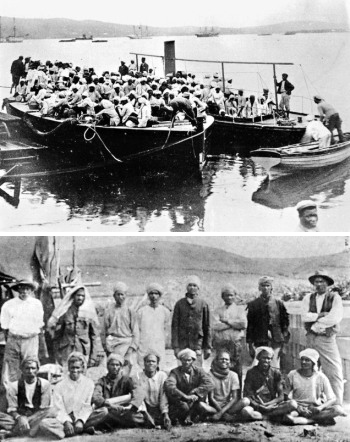Nov 08, 2025
Nov 08, 2025
“The sun never sets in the Indian Diaspora”, was said by Dr LM Singhvi – Chairman, High level committee of Indian Diaspora and former High Commissioner of Great Britain. He had held wide consultation with the Indian Diaspora of 20 million people before the establishment of the Pravasi Bharatiya Divas.
 The Indian civilization is founded on the principle of ‘Vasudaiva Kutumbatam’ – the entire world is one family. Where ever our brothers and sisters have gone, they have preserved the essential family and social values in their own communities and also spread them in the larger community they are part of. India is proud of the Indian Diaspora’s achievements. Where ever they are, they have earned a good name for themselves and for their mother country - India.
The Indian civilization is founded on the principle of ‘Vasudaiva Kutumbatam’ – the entire world is one family. Where ever our brothers and sisters have gone, they have preserved the essential family and social values in their own communities and also spread them in the larger community they are part of. India is proud of the Indian Diaspora’s achievements. Where ever they are, they have earned a good name for themselves and for their mother country - India.
Perhaps there is no other nation in the world that has such a widely dispersed Diaspora. This is a matter of pride for all Indians.
The Diaspora is proud of India’s vibrant democracy and the resilience of Indian democratic institutions. Indians adopt the way of life of their adopted country while preserving their cultural heritage play an important role in the society. Through their hard work and dedication, the community has done remarkably well in all walks of life and has earned respect for itself in the country of adoption.
In South Africa more than 1.2 million members of the Indian community of South Africa Celebrated 150th Anniversary of Indian arrival in South Africa…
 Today the Indian Community in South Africa have inherited the optimism and enterprise of their forefathers who docked in Durban 150 years ago with hardly a penny in their pocket but with a burning desire to ensure a better life for their families. The second and third generation South Africans is financially secure and many of them have scaled great heights in their areas of work.
Today the Indian Community in South Africa have inherited the optimism and enterprise of their forefathers who docked in Durban 150 years ago with hardly a penny in their pocket but with a burning desire to ensure a better life for their families. The second and third generation South Africans is financially secure and many of them have scaled great heights in their areas of work.
It was way back on the 10th November 1860 that the first boat load of Indians arrived in Durban, South Africa’s chief seaport. They came as indentured labour on sugarcane plantations owned by the White Community on the province of Natal.
The British Indian Government and that of Natal signed an agreement for Indian immigrants to work in ‘industrial service’ in South Africa for five years after which they were free to contract with employers of their choice. After 10 years, they would get a free passage home or, alternately, could receive a land grant equal to the cost of passage back to India.
Indians came from a wide area to Natal but the majority was recruited in Madras Presidency, Mysore, Bengal the Ganges Valley and Bihar. Recruitment was done in a professional manner - signing of contracts that stipulated men 35 years of age and women 30, with minimal wages, rations, accommodations plus free medical treatment prior to allocating them to many sugar plantations. Although their contribution to the sugar industry was over emphasized - their contribution to the over all economy has not received the attention it merits. Many Indians were in Tea, Coffee factories, Tobacco, Collieries in northern Natal plus Boat companies, Railways and in the Tourist industry - in all they played an important role due to their skills and experiences.
Indians in South Africa were amongst the earliest settlers in the country. What the White in SA did not for see was that most of the Indians opted for the land. Once developed into market gardens, these plots of land gave the settlers an income and independence. They soon had the monopoly of market-gardening in the vicinity of towns, delivering their produce to the markets.
Contribution and social influence has been considerable. The vibrant clothing and customs plus their architecture have made Durban a cosmopolitan city and Natal as a whole more interesting and less insular.
According to historian T.G. Ramamuthi in his book “Fight Against Apartheid” writes about the presence of these ‘Free Indians’ - the ones that settled in Durban in 1885 who owned land and the ones who joined them - business people from India who went into whole sale or retail trade.
Within two decades of their arrival, the population of South African Indians recorded spectacular growth. This disturbed the structure the structure of South African society, with its clear division between White masters and colored workers.
Indians from early days are to be found in all walks of life. A significant role is being played in every field including the political arena. The PAC leader Zeph Mothupeng who had been in Robben Island said in a meeting in UK “there are no Indians in South Africa but only African Indians!” - Most of the audience consisting of Indians cheered and accepted this definition.
When Thabo Mbeki made his “I am an African” speech in Parliament, he incorporated all the non Africans in the country as part of the African family….
In the late 1870’s the White rulers of Natal enacted laws, levied taxes and instituted humiliating practices in an effort to make the Indians ‘go home’. But according to the prominent South African Indian historian Ismail Meer ‘strong will, coupled with the anchor of religious belief’ - whether Hindu, Muslim or Christian saw the community persevere.
Gandhi who travelled to the country in the late 1890’s was drawn by their struggle. M K Gandhi floated the Natal Indian Congress and was instrumental in developing Indian responses to the discrimination faced by the community.
Almost since arrival the Indian community has been involved in and fought for equal rights - the most famous being M K Gandhi’s internationally known and admired “Satyagraha” non violent struggles against discrimination. Outstanding leaders have been produced in their political struggles in the country - also of a national character in several political organizations.
The minority White Government introduced Apartheid in 1948 and initiated a repatriation scheme for Indians with “all expenses paid one way trip home”, as a ruling of the Nationalist Party called it.
Very few availed of the scheme. Instead they preferred to improve their prospects as well as their children through enhanced education. 99.9 percent literacy rate today. The community’s struggle for racial justice ran parallel to the black South Africans struggle against Apartheid. The two movement joined course in 1951 till it finally led to the end of Apartheid in 1990.
South Africa which had been reeling under the injustice of apartheid perpetrated by the white rulers had been on the NAM (Non Align Movement) agenda right from the beginning. So when the white regime freed Nelson Mandela and the era of Apartheid came to an end in 1992 - it was a vindication of NAM’s stand and struggle.
As the barriers of Apartheid were gradually dismantled - the leaders of the Indian community in South Africa were highlighted in various field - business, industry, politics, medicine as well as education.
Many or most of the South African Indians have not set foot in India nor do they understand the language - but they have strong religious and cultural moorings. With the present generation - Bollywood is very much in favor. King Khan and his troupe from Bollywood were in Durban in January 2011 for the 150th anniversary. They celebrate all community festival, dress up in all finery for all occasions and cook Indian food at home and support the Indian cricket team as well!
For all their country of origin is a special place. India is in their mind. 150th year is a celebration of the ethos of a liberation movement.
Images of early Indian settlers in South Africa courtesy the Gandhi-Luthuli Documentation Center, Natal, South Africa
07-Oct-2012
More by : Rekha Bhattacharjee